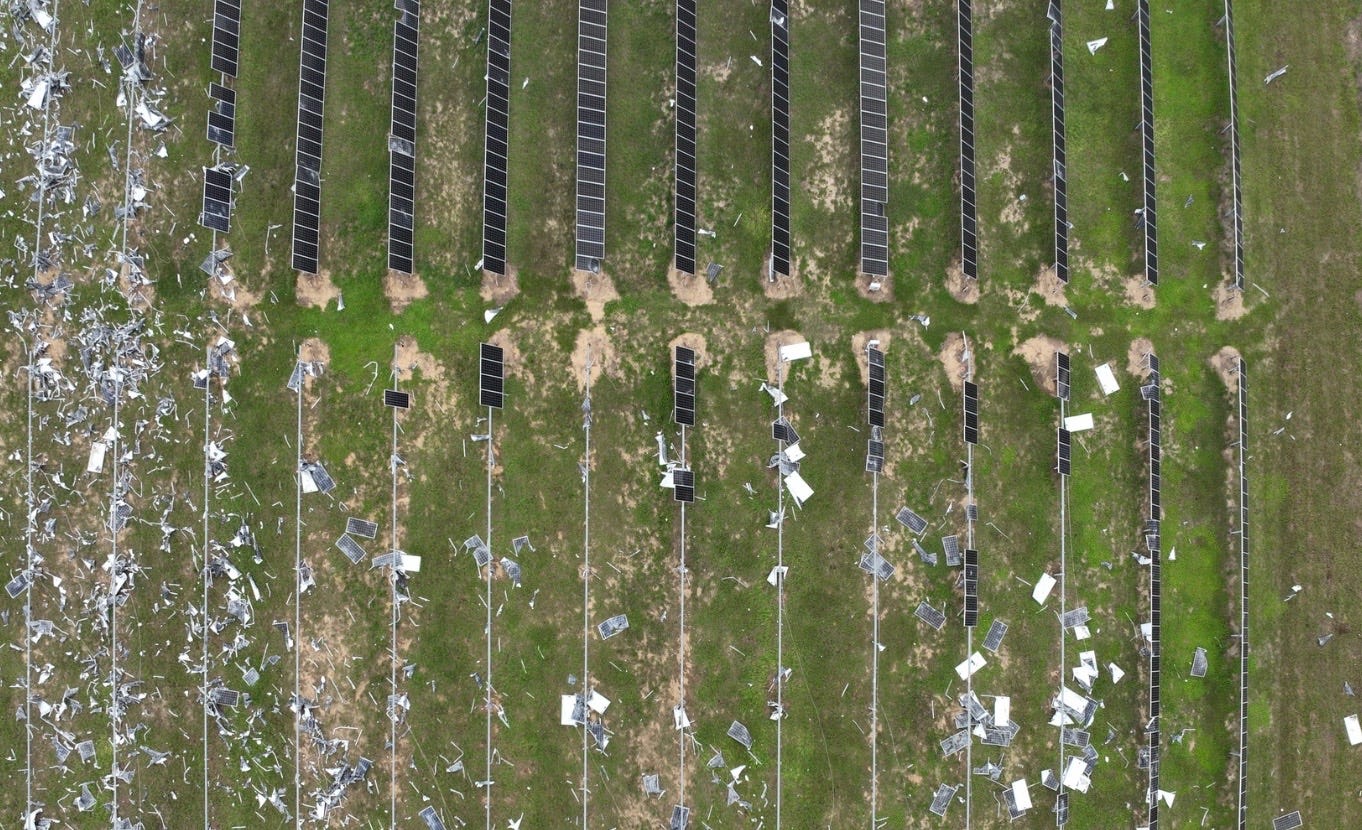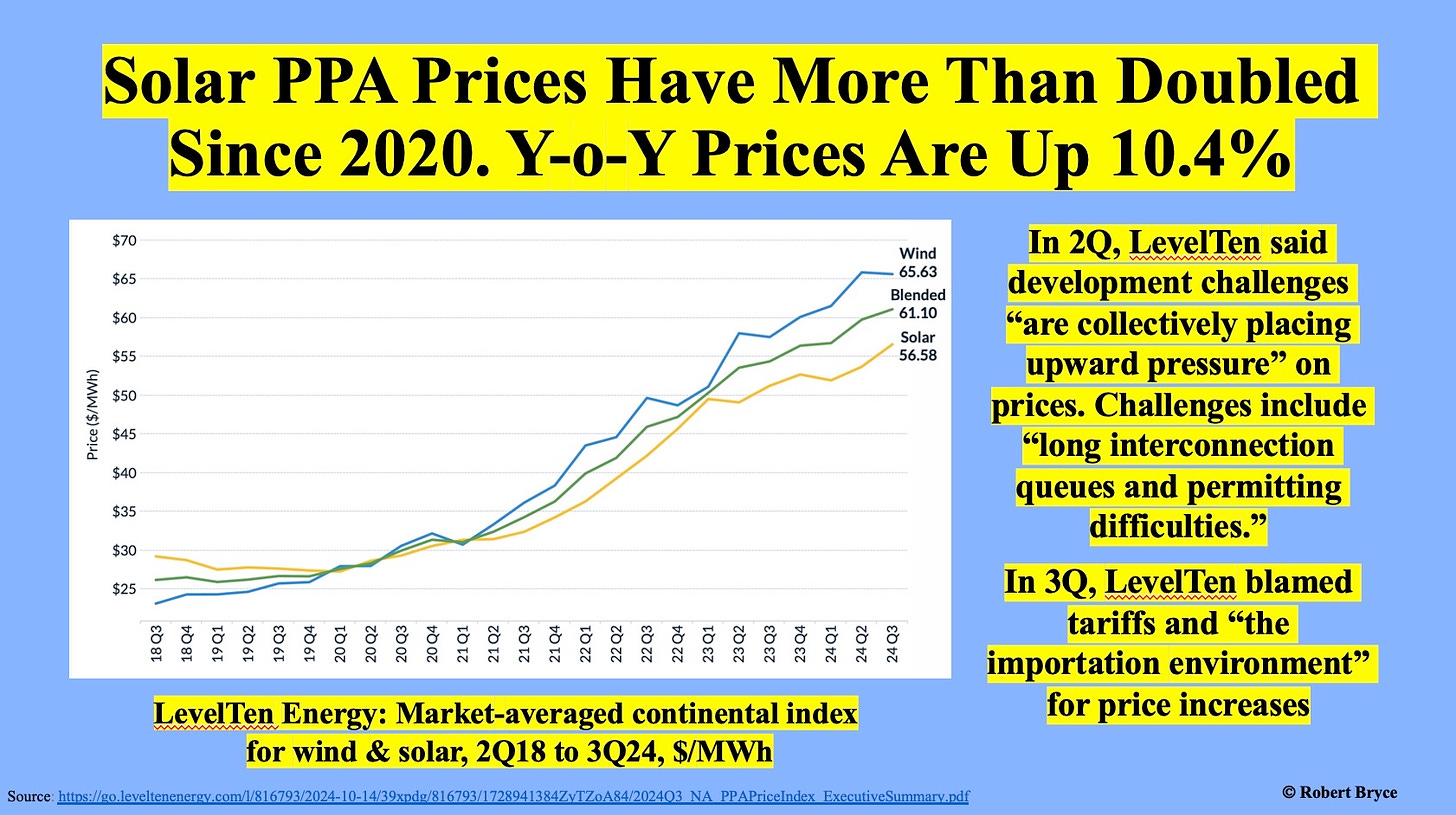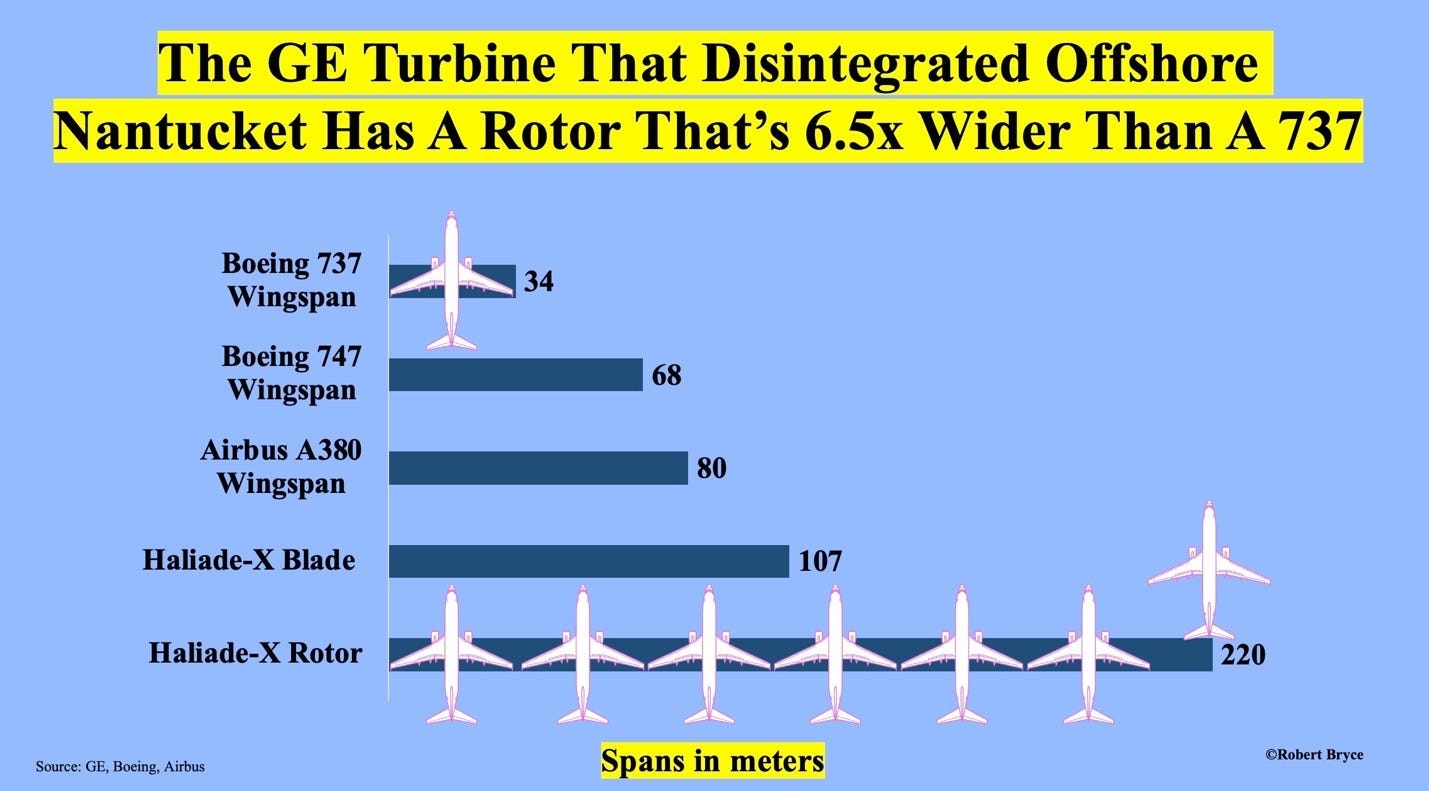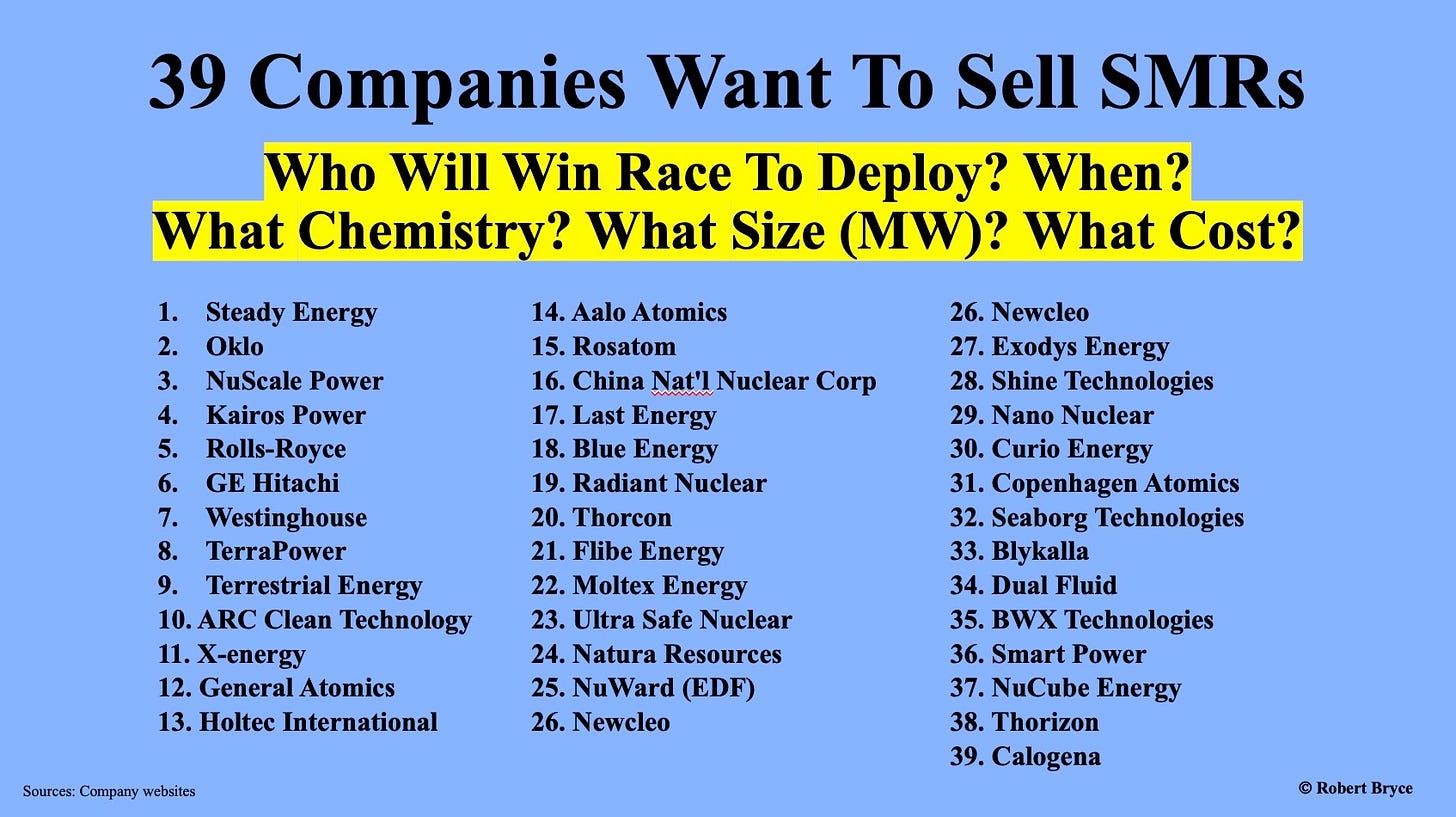Solar Costs Jump, More Offshore (And Onshore) Wind Woes, SMR Update, More H2 Cancellations
Koshkonong project cost jumps 42% in 19 months, GE Vernova takes $700M charge on its offshore wind business and will remove blades at Vineyard Wind, plus SMRs and H2!

The frequent flier miles are piling up. Last week, I was in Santiago talking about mining and hydrogen. This week, I was in Idaho Falls, speaking to the Idaho Advanced Energy Consortium about the energy transition, SMRs, and high-voltage transmission. Next week, I’ll be talking about electricity demand growth, inflation, and grid reliability in Huntsville with my friends at the Tennessee Valley Public Power Association.
Amid all the travel, I’m doing my best to keep up with the news. And there has been a metric ton of noteworthy energy news over the past few days. Among the most important items are the continuing increases in solar prices, particularly at the controversial Koshkonong solar project in Christiana, Wisconsin, and the storm waves lashing the offshore wind business. This week, GE Vernova (GEV) announced big losses in its wind business. It also admitted that more of the blades at the Vineyard Wind project are defective. GEV’s announcement led me to dig up the lawsuit American Electric Power filed against it in June. That lawsuit, which I’ve posted online, suggests that GEV’s manufacturing problems are widespread. I also have updates to the SMR list and new hydrogen project cancellations.
But enough with the teaser. It's Saturday, there are football games on TV, and I’m ready to see Freddie Freeman hit another walk-off grand slam in the World Series, so let’s cut to the chase.
Solar: It Ain’t Too Cheap To Meter
Alt-energy advocates never tire of claiming that solar energy is among the cheapest forms of electricity production. That’s true if you don’t plan on using electricity at night. It’s also true that the cost of solar projects is rising. Among the most vivid examples of that inflation can be seen at the 300-megawatt Koshkonong project, which aims to pave as much as seven square miles of prime agricultural land in Christiana and Deerfield, Wisconsin, with solar panels.
The Koshkonong project, which is being challenged in court by the town of Christiana, is owned by We Energies, Wisconsin Public Service, and Madison Gas and Electric. Last year, the utilities purchased the project from Chicago-based Invenergy, which is majority-owned by Canada’s CDPQ. The $649 million purchase was approved in March 2023 by the Wisconsin Public Service Commission.
However, in August, the companies notified the agency that Koshkonong would now cost more than $900 million, an increase of 42% in just 19 months. Ratepayers, of course, will likely be forced to bear that cost increase.
The utilities blamed the huge cost increase on increased tariffs on solar equipment as well as enforcement of federal law that blocks the import of Chinese products that are made with slave labor in China’s Xinjiang province. Danielle Kaeding of Wisconsin Public Radio reported last month that Wisconsin’s Citizens Utility Board has already “questioned the cost-effectiveness of the Koshkonong project before regulators approved it.” She further notes that the utilities pushing the solar project are seeking $800 million in rate hikes this year alone.
The cost hikes at Koshkonong are only part of the inflation wave hitting the solar sector. On October 15, LevelTen Energy released the latest edition of its PPA Price Index. The firm reported that prices for solar power purchase agreements rose 5.4% in North America during the third quarter. LevelTen said the price increases were due to “The importation environment for US solar equipment.” It continued: “The Biden administration has rolled out policies that increase tariffs on solar cells from China to 50%.” It also pointed to “forced-labor and anti-circumvention/anti-dumping laws,” which are “placing upward pressure on solar development costs.”
As seen above, solar PPA prices have more than doubled since 2020. In addition, the firm reported that solar prices have increased by 10.4% over the past 12 months. The third-quarter increase of 5.4% follows an increase of 3% during the second quarter. Level Ten said those price increases were due to “long interconnection queues and permitting difficulties.”
The soaring cost of solar energy doesn’t appear to be slowing solar capacity growth. During the first half of 2024, solar capacity in the US grew by 12 gigawatts. Wind capacity grew by just 2.5 GW. And the EIA expects solar capacity to grow by another 37 GW by the end of this year. That growth, of course, is being fueled by massive federal subsidies. Nevertheless, there’s also little reason to expect the cost of new solar to fall anytime soon.
GEV’s Turbulent Wind Business
GE Vernova, the company supplying the wind turbines for the $4 billion Vineyard Wind project in Massachusetts waters, is losing big bucks and now says it will have to replace some of the blades at the troubled 800-megawatt project. On July 13, a GEV turbine at Vineyard Wind had what the industry calls a “blade liberation event.” The shattered blade sent tons of fiberglass shards and debris into the ocean and fouled the beaches of Nantucket and other coastal towns in the region. Vineyard Wind, owned by Spain’s Avangrid and Copenhagen Infrastructure Partners, aims to install 62 massive offshore platforms smack in the middle of the known habitat of the critically endangered North Atlantic Right Whale. Each turbine will have a capacity of about 13 megawatts.
GEV blamed the blade failure on a “manufacturing deviation.” On Wednesday, the company said it would have to replace a “low single-digit” number of blades at Vineyard Wind due to the same manufacturing problem.
As I reported in July, and as shown above the GEV turbine blades in question are:
107 meters (351 feet) long and weigh 70 tons. In addition, the rotor of the massive machine spans 220 meters. For comparison, the wingspan of a Boeing 737 is 34 meters. In other words, the turbines at Vineyard Wind are nearly as tall as the Eiffel Tower and each of their blades weighs more than a fully loaded 737. As shown in the graphic above, the Haliade-X rotor is six and a half times wider than the wingspan of a 737. Given the enormity of the machines, it’s no wonder they are failing.
GEV has other wind-related problems. In addition to the offshore losses, it saw a 19% decline in orders due to a drop in onshore wind projects outside North America. That admission — and the company’s announcement that it will take a $700 million charge for losses in its offshore business related to the blade failures — prompted me to look again at the lawsuit Ohio-based American Electric Power filed against GEV in New York court in late June. AEP claims the turbine maker has refused to honor its warranties on the turbines that AEP has deployed at three wind projects in Oklahoma.
The lawsuit, which can be seen here, claims that GEV delivered turbine “generators and components” that:
failed or are at imminent risk of completely failing
were defectively designed
prematurely exhibited signs of failure, including spalling, cracking, etching, and breaking
failed or will imminently fail, after only two or three years of useful operation, and
were not suitable or fit for the purpose of generating electric power
AEP also says it is “reasonably foreseeable” that the turbines GEV supplied “will imminently and completely fail” and that despite the evidence of the widespread problems, GEV has “denied any responsibility for the defectively designed wind turbine generators.”
The suit also points to problems with GEV’s turbine blades. It notes a May 7, 2023, blade liberation event at one of the turbines that “originated from a crack on the leading edge at approximately 8-9 meters from the blade root.” It also identifies cracks on many turbine blades and delamination that “can progress and cause blade failures that could result in blade liberation.” The same problems GEV is having with Vineyard Wind’s turbine blades are also happening in its onshore turbines. Therefore, the disastrous blade failure that happened offshore Nantucket in July will almost certainly occur again with perhaps even worse results.
It’s impossible to know what the litigation might ultimately cost GEV. Still, it’s easy to assume that GEV faces hundreds of millions of dollars in additional losses due to problems with its onshore and offshore turbines and turbine blades. The calculation can be done by considering the 2023 lawsuit that GEV filed against SKF USA for allegedly providing it with defective bearings that GEV used in some of its wind turbines. GEV said it faces costs exceeding $386 million to repair and replace the SKF bearings.
Now, recall that in 2022, AEP paid $2.5 billion for the three Oklahoma wind projects, which have a total capacity of 995 megawatts. In its lawsuit against GEV, AEP says that wind turbines are expected to “achieve 98% availability. But at “one point in time” at one of the wind projects, “only 70% of the wind turbine generators” were operating properly. Assuming GEV has to replace 30% of AEP’s turbines, that comes to $750 million.
Whether these wind woes matter to GEV over the long term remains to be seen. However, the problems at Vineyard Wind and in Oklahoma show that the company’s wind business will be a drag on its profits for years to come. Despite this, due to the strength of its other businesses (and gas turbines in particular) GEV’s stock price is up 123% this year.
SMR Count Hits 39
Since last month, when I published “Nuclear Now? Part 2,” several people, including my friend Rod Adams, have sent me additional companies to add to the list of outfits hoping to deploy small modular reactors.
Earlier this month, World Nuclear News reported that the European Commission has selected nine SMR projects for potential deployment. The project list included familiar names, like NuScale, Rolls-Royce, and Last Energy. But I had not heard of Thorizon and Calogena. The EC plans to “facilitate deployment of SMRs in Europe by the early 2030s.” As I noted last month, a shakeout in the SMR sector is inevitable. There will be a handful of winners and a bunch of also-rans. Much depends on which companies can meet customers’ cost and scale demands. Please have a look at this updated list. If you have others that should be included, please let me know.
And More Hydrogen Projects Scuttled
This week, Spanish oil company Repsol announced it was halting all of its “green” hydrogen projects in Spain due to a fight with the government over a windfall tax. The company said it was stalling three projects with 350 MW of electrolyzer capacity for a year. (My bet: the stall will be permanent.)
Also this week, Finland’s Neste, has shelved plans to install a 120 MW electrolyzer to produce renewable hydrogen at its Porvoo refinery. The company blamed “challenging market conditions and financial performance, requiring critical assessment of any new investments.”
Earlier this month, the Investigative Post reported that Plug Power, which calls itself “the industry leader behind the end-to-end green hydrogen ecosystem,” has halted construction of its hydrogen production plant in Genesee County, New York. Plug has received massive subsidies from the state of New York and the Department of Energy. Plug’s stock price has fallen 53% this year.
Before you go:
As always, you will do me a favor by clicking that ♡ button. And you’ll do me an even bigger favor by becoming a paid subscriber. Thanks.







Informative article, thank you! We have been resisting utility-scale solar on farmland in Callaway County, Missouri for approximately 3 years. I cannot for the life of me understand why any responsible county commissioner, state legislator, governor or federal legislator would be in favor of permitting wind or solar construction that destroys farmland in 2024. The money coming back to the county in tax revenue or PILTs is a smoke screen meant to conceal the real costs to the community -- communities are going to be destroyed because the small businesses that support the agriculture in that community are going to fail, crop revenues will be lost, the land will be destroyed for future agricultural use, and no one is looking at this impact. Before January 1, we expect our commissioners to sign an agreement with Ranger Power. Savion/Evenergy is also waiting in the wings. Interestingly, recent elections will replace 2 of the 3 commissioners responsible for signing this agreement. The plan seems to be to have the agreement signed on their way out before the new commissioners can be sworn in on Jan. 1, leaving the 2 new commissioners with the fall-out of their decision and the flood gates opened for solar development at utility-scale on prime Missouri farmland. The greed of 29 leasing landowners overcomes the voices of 195 opposed non-leasing landowners whose voices cannot be made to count. We worked hard to get a commissioner elected within our district who we believed would take the concerns of non-leasing landowners into consideration. However, Ranger power will be in before this individual takes office. Despite massive effort on the part of the Mid-Missouri Land Owners Alliance over several years, failure is imminent. Our government has failed us.
Great data and informative as always. Earlier this year a large tree fell in our backyard. Now I realize it was simply a Vegetation Liberation Event.